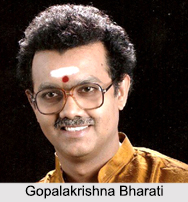 Gopalakrishna Bharati was a Tamil poet and a well-known Carnatic music composer. He consequently composed one of his most popular "kritis" in "Sabhapatikku". He wrote "Kathakalatchepam" and "Nantanar Charittiram". He was the contemporary of other famous Carnatic music composers like Tyagaraja and Muthusvami Dikshitar and Syama Sastri.
Gopalakrishna Bharati was a Tamil poet and a well-known Carnatic music composer. He consequently composed one of his most popular "kritis" in "Sabhapatikku". He wrote "Kathakalatchepam" and "Nantanar Charittiram". He was the contemporary of other famous Carnatic music composers like Tyagaraja and Muthusvami Dikshitar and Syama Sastri.
.
Early Life of Gopalakrishna Bharati
Gopalakrishna Bharati was born in 1810 AD in a Brahmin family in Narimanam, near Nagappattinam District in Tamil Nadu. He spent his early days in Mudikondan village, near Thiruvarur. A few years later he moved to Anandathandavapuram village, near Mayavaram. He took his basic education from his father Ramaswami. Both his father and grandfather were `Veena` artists.
Later, he took teachings in Sanskrit and travelled to the places like Tiruvidaimarudur, Konerirajapuram and Anandatandavapuram for learning under many other teachers. He came back to Mudikondan at the end and that`s why he was also known as Mudikondan Gopalakrishna Bharati. After the death of his parents at an early age, he worked as a cook in a temple. Then he met with Govinda Yati, who taught him Hindu scripture, and then the musician Ramdas, who taught him the Hindustani music.
Works of Gopalakrishna Bharati
Gopalakrishna started his professional career after finding a benefactor named Annu Iyer. He composed several "kritis" on the principles of "advaita" portraying numerous musical concealments. He is still famous for his various compositions but mainly for his enduring Tamil opera, known as `Nanandanar Charitram`. It was about "Nandanar", who was one of the sixty-three Tamil "Saivite" saints. It said that once "Tyagaraja" asked him to write in the raga `abhogi`. Then, he wrote his most popular "kritis" in `Rupaka Tala` and `Capapatikku`. He was never inclined to the worldly life and was devoted to Lord Siva, which took him to Shiva temples near the Kaveri River. He also loved listening stories on the "Saiva Nayanmars". He wrote many songs on Lord Nataraja of Chidambaram. He also composed musical narratives about other "Saiva Nayanmars" like `Iyarpakai Nayanar Charitram`, `Tirnnilakantha Nayanar Charitram` and `Karaikkal Amtnaiyar Charitram`. He also composed "Varugalamo" (Manji), "Varuvaro" (Sama) and "Enneramum" (Devagandhari).
While writing `Nandanar Charitram`, he brought a little change in the original story. He added a new character named `Vediya` as the landlord. In this story, Nandan was assumed as an outcaste labourer and devotee of Lord Shiva, who desired to get the "darshana" of his Lord. The landlord `Vediya` always prevented him in doing so. The story revolves around these two characters. He was an "uncchavritti" Brahmin, who supported himself by eating the food given as alms. He had also performed many "katha kalakshepas" and he raised the status of it. Many of his students, including "Vedanayagam Pillai" who was the District Munsif at Mayuram were taught a number of his songs by Gopalakrishna. His songs became very popular and they are also sung in many of the present day dance-recitals.
Compositions of Gopalakrishna Bharathi
•Aadum cidambaramo - behaag
•Arivudaiyor - cakravaakam
•Cidambaram - begada
•Edo teriyaamal - hameer kalyaani
•Enneramum - devagaandhaari
•Eppovaruvaaro - shenjurutti, jonpuri
•Innamum sandehappadalaamo - keeravaani
•Irakkam varaamal - behaag
•Kaaranam kettu vaadi - poorvi kalyaani
•Maname unakkhitamaai - aananda bhairavi
•Natanam aadinaar - vasantaa - gb
•Sabaa patikku - aabhogi
•Satru vilahi - poovi kalyaani
•Shivakaama sundari - jaganmohini
•Tandai taay - mukhaari, shhanmugapriyaa
•Tiruvadi sharanam - kaambhoji
•Varugalaamo - maanji
•Varuvaaro varam taruvaaro - shyaamaa
Performance of Gopalakrishna Bharati
Bharati performed the "Nandan Caritiram" which was very popular. The highly regarded "Thanjavur Krishna Bhagavatar," made it one of his masterpieces. The story of "Nandanar", as Bharati had major significance with the Nationalist movement in India. Bharati`s "katakalatcepams" were very popular in "Karaikal". Karaikal was then a French colony.
Death of Gopalakrishna Bharati
Gopalakrishna Bharati died in the year of 1896 at the age of 86.




















